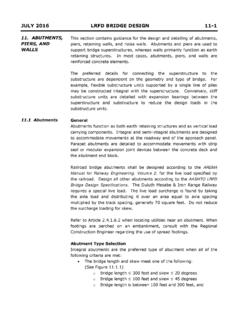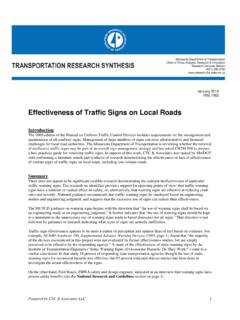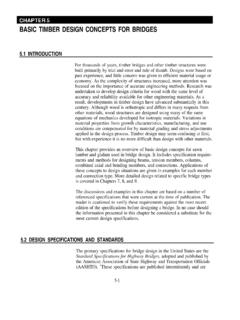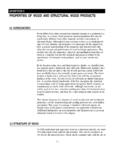Transcription of Comparison of the Dynamic Cone Penetrometer with Other ...
1 John A. Sit:kmeit:r', Duane Young', aind David Beberg'. Comparison of the Dynamic cone Inenertrorneteirwith Other Tests During Suibgradle aind Graiiular Base Clharacterization in Mixlinesota Refert:nce: Siekrneier, J. A., Young, I)., and Beberg, D., 1999, " Comparison of the Dynamic cone E'enetiromet~erwith Other Tests Ihring Subgrade and Granular Base Chairacterizatiom in MlinnesotaL," Nondestructive Tcstimg ofPavements and Rackcizlculation oJModuli: Third Volume, ASTM STY I 3 75, S. D. Tayabji and E. 0 I dcrxnen, Eds., A,melmcan Society for Testing and Materials, West Conshohocken, PA. Abstract: During the 1998 construction season, the Dynamic cone Penetrometer (DCP), Loadman portable falling weight clefleictonreter (PIP WD), and Humbolldt soil stiffness gauge (SSG) were used to characterize the subgrade and granular base for several projects in Minne sota.
2 The DCP penetration index (DP1) was conwertcd to modulus using ' , California bearing ratio (CBR), and previously established1 con'eli%tion:;between the I 111. rnoduliis Standairtl FWID tesls were also pcrformed at some locations and the moduli backcalculated using 1WE:IRC:ALC. The moduli were then conipared to determine the ability of' each device to accurately measurc: in situ stiffnw;. Finally, thin-wall and bag samples .were collected from some locations for laboratory resilient modulus testing and the results compared t~ the Geld-derived moduli. The results show the stress dependent nalure of the materials lested and that a strong correlation exists between the instruxnenls that are designed to measure modulus. The results also show a wcaker, yet still useful, correlation between the strength, as measured with the DCI', and the elastic deformation modulus, measured using the PFWD.
3 And SSG. Keywords: DCP, granular base, Loadlman, mechanisiic, modulus., specifications, subgrade, stiffness Research Engineer, Pavement Design Engineer, and Senior Grading and Base Specialist, respectively, Office of Materials and Road Research, Minnesota Department of Transportation, 1400 Gervais Avenue, Maplewood, MIV 55 109-2044. Int rociuction l'he Miinnesota Department of Transportation (M n/DC)T) has traditionally utilized experienccd engineer:: and technicians to evaluate the strength, stiffness, and uniformity of subgrade soils and granular bases during construction. Their evaluations utilize compaction testing, test rolling, arid eingineeringjudgement to accept suitable areas or identify areas t hat require additiorial improvement. To improve the evaluation, Other tools are required1 thaf prcpvidle quantitative data.
4 These tools must be: both portable and capable of providling accurate results in the field. Cunently in Minntxlta, quality assurance testing of the subgrade ancl granular base ma1crials is based on a combined "recipe" ancl end-product specification., which consists mainly of"soil classificatim, gradation, moisture control, lift thickness limits, and compaction testing. With tha: coming transition from empirical to mechanist ic-empirical pavemerit design procedures. it will be advantageous to move towards more mechanistic- based specifications (Fleming et al. 1998, Il'idwerbesky 1997, Pinard 1998, van Niekerk et a! 1008). Rlechanistic-based specifications ii~cuson t,he mechanical properties of the niaterials. Thi:s i:; desiirable becau,seit facilitates quantitative cvaluation of alternative clonstrilclion practices ,and materials, such as reclaimed materials (Fleming 1998), both of which have beneficial (costand environmental implications.)
5 Iin the future, it is cxpected that quality assurance testing in Minnesota would include in situ shcar strength and modulus imeasurement irsing the Dynamic cone Penetrometer (DCP), Loadman portable falling weight dcflectometer (PFWP)), and Humboltit soil stiffile:;:; gauge (SSG). These field measurements would be compared to the shear strength1 and imodulus usled fix design in order to verify the design assumptions. H[owevei*,because material properties change with time clue to changes in moisture, temperature, arid Other factors it will be essential that seasonal adjustments be considered. The in situ measurements coiuld also be used to quantify incentive-based contracts that reward contractors for producing higher quality products. Bonuses could be paid in proportion to an increase in stiffness and uriiformiiy above a minimum specified.]
6 Accurate itneasureme~itof in situ properties continues to be a challenge that requires both appropriate devices imd methods (Newcomb and Birgisson 1999). In addition to the prc,ject summarized in this paper, others are conducting similar efforts that compare various (devices(Chen and Bilyeu 1999). As a result, it is expected that the DCP, PF WD, aind SSGr will become more common. at pavement construction sites throughout the nation its more public and private organizations learn of their utility and specific criteria are defined. Beginning in 1991, MdDOT began investigating the use olf the DCP for a variety of appllications. The IICP was found lo be a quick and inexpensive testing device that provided a quantitative measlire of the in-situ shear strength of soils and Other materials.)
7 Based on 1,liatfield experience, Mn/DOT incorporated the IICP into its specification for p,avement edge drain backfill and granular base cornpaction (Siekmeler et al. 1998). In addition, to facilitate greater use of thc DCP, Mn/I>OT began the "DCP Loan Program" in 1'998. The program allows interested publiic and private organizations in Minnesota to borrow a I>CPfoir a month to becoinc familliar with the dcvice. More than a dozen DOTS. and Fedmil agencies are currently using the DCI' and several, including Minnesota, Ohio, and Florida, have manufactured automatd 1r)CPs (Parker et al. 1998). Many useful correlatiions between lhe DCI' penetration index (DPI) and Other material properties continue to be reported (Vantlre et a1 1990). Interesting relationships between the shear strength, moisture susceptibility, resilieril modulus, and clectrical properties of base course aggregatcs are being developed ( et al.
8 I 998). Others have shown corrchtions between the IIIPI ;and various moduli (Chua 1988, Newcomb et al. 1996, Syed and Scudlion 11998). Test Locations Testing was performed for 13 (differentpavement sections at five locations around Rlinncsota. Location I was located on Interstate 94 south of MonLicello at the Mn/ROAD. test facility. Testing was performed on seven of llie test sections located on the interstate as part of ii forensic evaluation of those tesl sections. Lolcation 2 was located on the low volume lest road, also located at the Mn/ROAD nest facility adjacent to the interstate. Tesling therz ~ 7 2 ; ! s on three of the aggregate surfaced test sections. L,ocation 3. was located on st,ate'1'13 169 near IOnamia, location 4 on ;stateTH 12 west of Delano, and location S on state TI-1 610 in Coon Rapids.
9 Testing Ekpipment- The Dynamic cone Penetrometer (IICP) was used to measure the shear strength from which a deformation mlodulus w a estimalcd. The I ~mdimanportable falling weight dleflectorneter (P WI>),Humboldt soil stiffness gage (SSG), and Dynatest falling weight dleflectorneter ( FWD) were used to estimate an ellastic deformation modulus. Laboratory resilient modulus tests were performed on thin-wall samples of the cohesive subgrade materials and recompiicted samples of the granular base materials. Finally, conventional sandcam: (SC) and nuclear gauge ((NGr)tests were used to measure the density and moisture. l'kie DClP used by MndDOT (Figure 1) consists of' an 8-kg lhammer that falls 575. rrim and drives a 60-degrec 20-mni-diametc;r cone into the soill or aggregate base.)
10 The DCI' produces shear failure in the material and is most useful for verifying consistency and uniformity at specific coinstruction site:;. It also supports more accurate cornmimication between the field vbserver and the office because it provides a consistent qiuantilative mmsure o f the strength. The PFWD (Figure 2) is a portable device used to estimate the in situi modulus by measuring the deflection beneath it falling weight. The device can be used on rnost ui~boundmaterials u s d in normal pavement engineering appliicatiions. The total weight is 16 kg, the height is 1l;TO mm, and the diameter is 130 mxn. The deflection is caused by dropping a 10-kg weiglht 800 mm inside thc hollow body of thle device on to a loading pliate, which rests on the material being tesled. 1'WQ different loading plates, with diameters of 132 mm and 200 mm, cain be used depending on the stiffness oflhe material being tested.











